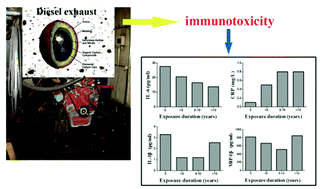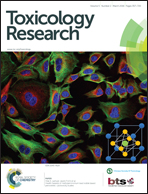Long-term exposure to diesel engine exhaust affects cytokine expression among occupational population†
Abstract
Diesel engine exhaust (DEE) is a predominant contributor to urban air pollution. The International Agency for Research on Cancer classified DEE as a group I carcinogen. Inflammatory response is considered to be associated with various health outcomes including carcinogenesis. However, human data linking inflammation with long-term DEE exposure are still lacking. In this study, a total of 137 diesel engine testing workers with an average exposure of 8.2 years and 108 unexposed controls were enrolled. Peripheral blood samples were collected from all subjects, and the association of DEE exposure with inflammatory biomarkers was analyzed. Overall, DEE exposed workers had a significant increase in the C-reactive protein (CRP) and a significant decrease in cytokines including interleukin (IL)-1β, IL-6, IL-8, and macrophage inflammatory protein (MIP)-1β compared to controls after adjusting for age, BMI, smoking status, and alcohol use, and findings were highly consistent when stratified by smoking status. In addition, exposure time dependent patterns for IL-6 and CRP were also found (Ptrend = 0.006 and 0.026, respectively); however, the levels of IL-1β and MIP-1β were significantly lower in subjects with a DEE working time of less than 10 years compared with the controls and then recovered to control levels in workers exposed for >10 years. There were no significant differences in blood cell counts and major lymphocyte subsets between exposed workers and the controls. Our results provide epidemiological evidence for the relationship between DEE exposure and immunotoxicity considering the important roles of cytokines in immunological processes.


 Please wait while we load your content...
Please wait while we load your content...